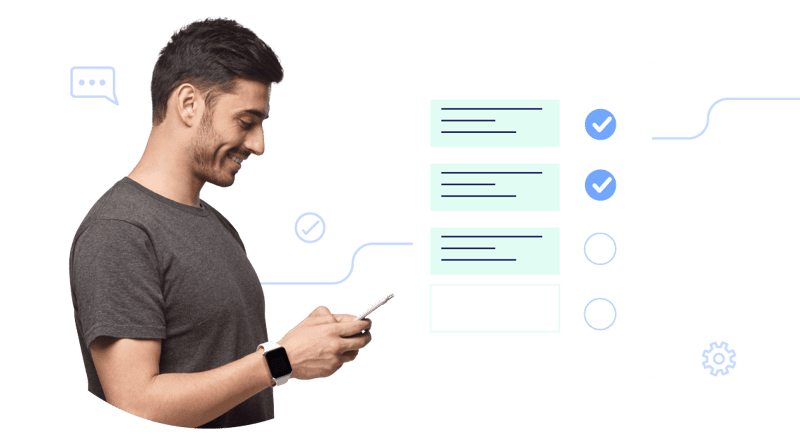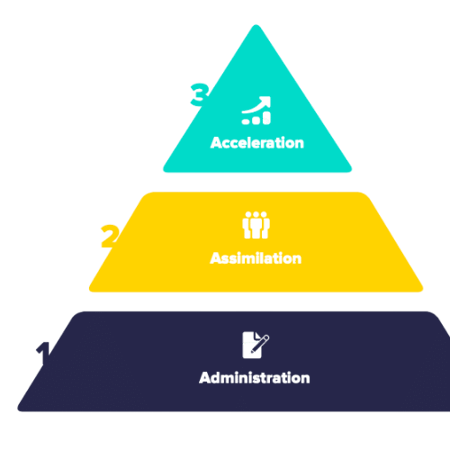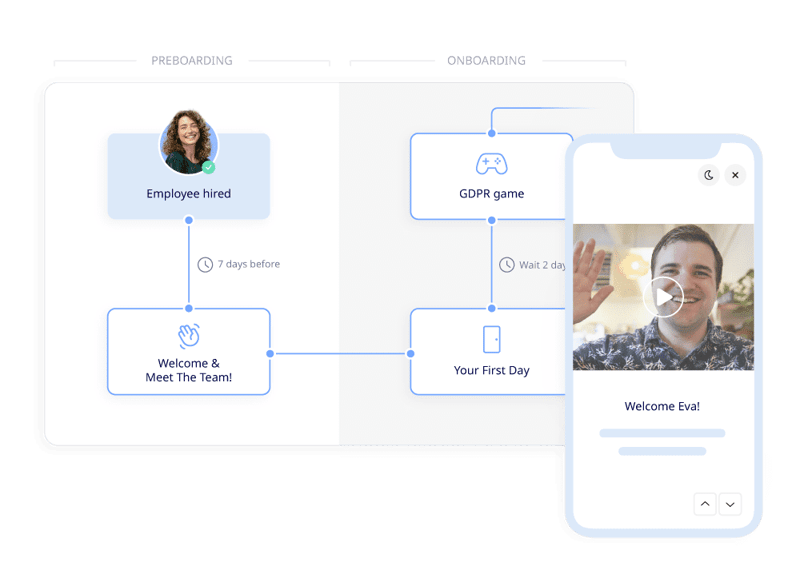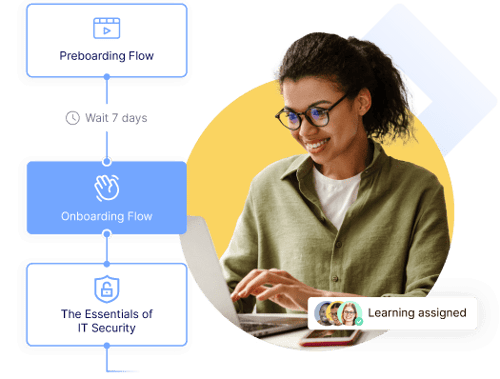Onboarding New Employees: Everything you need to know & how to start
Onboarding is the process and activities you give new employees to create a sense of belonging, knowledge of your organization, and helping them getting fully started in their new role.
On this page, you can learn more about onboarding and how you can apply it to your company. We'll give you materials and insights for inspiration.

Give employees a fantastic start with onboarding

In short, structured and engaging onboarding plays a part in attracting talents, retaining employees, and making them effective faster. And remember this; the best onboarding has a complete focus on the employee.
If the onboarding is not proper, people rarely stay with the company for long. Especially the talented employees are likely to leave, perhaps because they have been offered several positions before they said yes to you.
Structured onboarding also gives the new employee a sense of belonging to the workplace quickly, as well as a sense of commitment to the company. In addition, onboarding is also about maturing your new talented employees and make them able to perform their very best for you.
Read more on this page to get further knowledge about onboarding as well as practical tips and inspiration you can use.
Why should you focus on onboarding in your company?

Onboarding is getting increasingly more important to companies for good reasons. Let's start by showing you some great benefits of onboarding.
Benefits of onboarding new employees in your company
- A great welcome and well-tailored onboarding program increase employee retention
- Onboarding programs minimize time-to-performance in more than 60 % of cases
- You save costs. Employees are a costly asset in the company - especially if you lose them fast. 25 percent of all employees hand in their notice within the first year, and it costs a company about 75.000 USD if a salaried employee quits after 4-6 months
- Engaged employees deliver better results and effective onboarding increase employee engagement with more than 20 %
- The value of onboarding is also monetary: Here's how to calculate the value of onboarding
Get all our facts about onboarding and what other benefits it can give you in our free and insightful onboarding guide.
The big onboarding guide
Tips to fantastic onboarding that retains and creates results.
The technical, digital, and practical in onboarding

Make sure to have all the simple stuff in order and to get both the new employee and everyone else in the organization on board the onboarding train from the beginning – also with the right technology.
The best onboarding process is done in the first 90 days of your new employee's time in your company. But how do you actually carry it out? Here are some insights and tips to create a structured and engaging onboarding process.
4 key points: What is successful onboarding?
- Onboarding begins the moment the employee takes the first step inside the new workplace and continues several months further forward.
- Remember that even though onboarding takes time, it creates engagement.
- Everyone should be part of welcoming the new employees.
- Remember to get some effective digital tools incorporated into your onboarding.
Who should be in charge of our onboarding?
If you don’t have an HR department in your organization, then make sure that the onboarding is managed by a person who is used to train new employees. Alternatively, it can be a person who has worked closely with many types of employees and who has a good insight into the work processes in the company.
So, it should not just be one manager who is in charge of the onboarding. If the manager does not have an HR mindset and has not understood how difficult it can be to be a new employee, it can easily be about fast results and that the employee just has to get started with delivering right away.
It is a good idea to let HR ask the employee how things are going — just a 15-minute weekly catch up in the beginning.
Some employees feel that if they do not meet their goals, then they are not good enough.
Instead, it can feel more secure to confide anonymously to HR, and at the same time, it is easier for that person to see the warning signs, if he/she asks about what the new employee precisely has understood of his/her work tasks and new role.
Even though we would often like to keep people for more than three years, it is possible that the recruiting was a mistake. For example, if the employee has a hard time communicating and often gets misunderstood.
Then they need to get feedback on that from the start, and if it gets better after that, you can then praise yourself that you did something at the right time.
If things are not getting better, you stay stronger as a company, if you need to go separate ways before the trial period is over.
This has to be included in the onboarding: The Onboarding Pyramid
You can use the onboarding guide to help you create the structured onboarding you need. It has three steps: Administration → Assimilation → Acceleration (Lever, 2019). All three steps are important if you want a successful onboarding of new employees.
Part of the process is also preboarding. Preboarding begins when the employee signs the contract until the day they start. You can read much more about preboarding employees here.
 1. Administration
1. Administration
In the onboarding pyramid, the administration step is the most basic step that gets all the formal stuff in order and creates the starting point for the continuing onboarding.
Everything that needs to be signed is in the administration step. It is employment contracts, NDAs, etc. In addition, you need to make sure that everything is ready for the new employee in practice. Is the desk ready to be used or is the uniform ordered in the right size? Has the new employee access to your learning platform?
2. Assimilation
On the assimilation step, the new employees must be included in the social life in the workplace and learn about the culture.
In addition, it is important that they are trained in your internal policies (compliance training), get well into the work tasks, and at last but not least be aware of which expectations there are to them and their work effort.
A study from Gallup (2015) shows that only 15% of all employees strongly agree that they know what is expected of them at the job. And if they are not aware of what is expected of them, how can they then live up to the goals and create results in your company?
3. Acceleration
The acceleration step is about getting the employees to accelerate in their roles so they can create success and results for your company. They have to be able to express their authentical self without concerns and have the opportunity to develop in the workplace.
When the employees are safe and can express their personal, authentical self (read more p. 10), they can accelerate their role and create results for your company. When they are safe and can be the best version of themselves at work, they will automatically be able to place a complete focus on the work tasks without having to worry about whether they fit in.
In this step, they also understand what is expected of them and what it takes for them to meet the goals. That is why it is a good idea to be open to give them training, so they can develop and manage work tasks better and create even more beautiful results for your company.
Onboarding Seasonal Workers
How do you adapt your onboarding and set your seasonal workers up for Success?
How to create onboarding for remote workers and freelancers

As the gig economy increases, companies must also look at how they onboard freelancers, in order to make sure freelancers or temporary project hires understand your mission, vision, and values. Connecting freelancers to your culture and giving them a sense of belonging pays off.
Onboarding remote workers
Hiring remote workers is increasingly common, and there are actually quite a few benefits to reap from allowing employees to be remote. However, how can you create onboarding for remote workers?
The solution of course lies in digital onboarding, which we write more about in the next chapter on this page. Again, you need to remember the onboarding pyramid: administration, assimilation and acceleration.
If we first look at administration, how are you going to fulfill important document signings of NDAs and contracts, etc.? There are tools that can help you with digital signatures to ease the process - no need for a fax. Next up is making sure the employee has the right conditions to work in - at home. Do they have the right chair? A good wifi-connection? A screen that is at the right height? The list goes on - The important thing is to secure that your employees work correctly and stay healthy.
Next up is the assimilation stage; how are you going to make sure they are included in the social life in the workplace and learn about your culture?
This one is tough - humans needs to be physically social. But you can still do a lot. Make sure you book online lunch meetings, arrange a digital social buddy program - for example, a walk and talk over the phone (fresh air is important too) - this is about creating a sense of belonging socially, and the more engaged everyone is in the digital onboarding the better.
Finally, this stage is of course also about getting expectations aligned, making sure goals are clear, and what your new remote hire can do to reach results. Your new remote workers need to get well into their work tasks. Did you know onboarding can help reduce time-to-performance in more than 60% of cases?
You need a platform where people can easily access material in their work, company info, and more. Being able to always look back at any moment is important - this is where digital learning can help you a lot. Which brings us to remote onboarding in the acceleration stage.
In the last stage of the onboarding pyramid, you want employees to accelerate in their roles. To be more engaged, to empower them to evolve and grow. This increases their happiness and productivity. Using digital training tools you can help remote workers develop in the direction that suits them and hopefully also matches the needs of your company. You want to make it accessible, entertaining, and relevant to your employees, which is why we recommend a user-friendly learning platform for training that uses interactive and gamified content.
See this list with tips on onboarding remote employees.
What about employees who are not used to work remotely but have to do it now?
Especially after Covid-19 entered our lives, many people were forced to work from home. In Learningbank, we are lucky to have learning experts and psychologists working with us.
One of our dear colleagues is Malene, who shares some tips on working remotely in this video:
We use this video internally as well, and as new people arrive in our growing family, we make sure they are readily onboarded to maintain work from home.
Onboarding of freelancers
Freelancers can to a higher degree need onboarding than permanent employees, as they often do not have the possibility of popping in at the manager with questions. If a freelancer does not have proper knowledge about the project or a good grip of your values and needs in the company, there will be a bigger risk of him/her making mistakes.
If you have some from the growing group of freelancers working for you from time to time, they should also be included in your learning program on the same terms as the other employees. In that way, they will also be able to handle work tasks for you in the best way if they know your way of doing things beforehand. And that also applies to everything from company culture to data protection, where especially the latter can have financial consequences for you if the legislation is not complied with.
Three specific steps to onboard freelancers:
- Intro: create a visual connection to the team
Instead of a phone call and e-mail correspondence, it creates a better connection if the freelancer can see the people he or she is going to work with. - Give access to digital preboarding and onboarding
Freelancers can take the digital onboarding when it fits their schedule, and they can easily go back during the project and follow up on information about your company if need be. - Make sure the technology is in place
All the technical stuff needs to be completely in order before a freelancer begins working for you. As it is frustrating, both for you and for the freelancer, if the project has been started and then it quickly drowns in administrative delays. Make sure to also give access to all your communication channels, programs, and file sharing systems before project start.
In this blog post about onboarding of freelancers, we go more in-depth about the three steps and you will also learn what consequences there are of not having onboarding for freelancers.
Think about the employee journey in your onboarding

The employee journey, or the employee lifecycle, is the steps your employee goes through in your company from pre- and onboarding until he or she decides to resign, in other words enter your offboarding.
We have written a total guide to the employee journey that takes you through every step you need to consider. The point here is, that your onboarding should also prepare the employee in regards to the other stages of the employee journey. For example, what do you do, when a person switches jobs internally? This person needs to be onboarded again - what is also called "reboarding".
A great example of onboarding for the whole employee journey is McDonald's. With Learningbank, McDonald's created a whole new learning universe that begins right from when their new employees are hired.
You can learn a lot from the actions McDonald's took to create their award-winning employee experience, that keeps developing people with learning and training after the employee has been onboarded.
Tips to Enhance the Employee Onboarding Process
With Christopher Pappas from eLearning Industry, we share 5 creative ways to extend onboarding training into every stage of the employment cycle. Here are some of the tips we share:
- Host Monthly Events
You have probably heard about Facebook's, Google's, Apple's, or Microsoft's internal keynotes with their CEO, where employees are able to ask the CEO everything. Today's generation of employees in your workforce wants to be heard more and giving them the opportunity to raise their voice, and you listen to them, creates a powerful sense of belonging.
-
Craft Individual Career Journeys
Everyone has dreams and ambitions to become better, move forward in their life, and ultimately keep pursuing career options to fulfill their personal goals.
This is a really important part of onboarding. You have to make sure that your onboarding also includes the opportunities of crafting their own up-skilling and, if necessary, their opportunities to switch into a new area of expertise. Include for example online course training, offers for mentorships, or other guidance that your HR can deliver.
E-book: Guide to great preboarding
Learn more about preboarding in your onboarding process.
Why digital onboarding matters - a lot.

Digital onboarding leverages the availability of digital tools and technology to make the onboarding process as cost-effective and efficient as possible.
Onboarding is a critical part of the employment life cycle, and an opportunity to immediately and effectively introduce the employee to the culture of the organization and set them up for future success. We already covered a lot of good insight on how to execute digital onboarding for remote workers but here you can read a bit more on why it matters and what tools you can use.
With digital onboarding you can more effectively introduce employees to your organization and set them up for future success - this increases your onboarding efficiency, reduces the time you spend on onboarding, and your talents are more likely to stay with you longer.
Digital onboarding at scale
With the many tools you can use to digitize your onboarding there is a powerful benefit - you can reach 1000s of people at once globally. This means accurate information gets delivered properly and you save time executing your onboarding. You also have the possibility to use onboarding videos so you can provide a much better employee experience to new-comers.
What other tools can you use to enhance your digital onboarding?
A combination of both face-to-face and digital onboarding activities will serve to provide the richest and most rewarding experience for employees. Today’s employers have a wide range of tools and options available to them to aid the employee onboarding process:
- Email is a commonly used digital platform to connect with and engage, employees throughout the hiring and onboarding process
- Digital signatures and electronic document handling to minimize paperwork, provide an electronic repository for critical documents, and streamline approval processes
- Chatbots can be used as a tool to respond to common employee questions or requests
- Video conferencing – live and asynchronous – making it possible to extend the useful time of a training session and ensure consistency
- Podcasts, webcasts, and videos that can be offered on-demand
- Interactive websites for employees to sign up for benefit coverage, participate in training and in-service activities and communicate with other staff members
- Employee portals that can be customized based on employee needs and allow access to personal information
- Automated polls used as a means of gathering information and opinions from employees throughout their early days, weeks and months with the company—and beyond
Read more about best practices in digital onboarding and how you carry it out in our blog post on digital onboarding trends here.
Download Our Onboarding Guide
& Learn More

